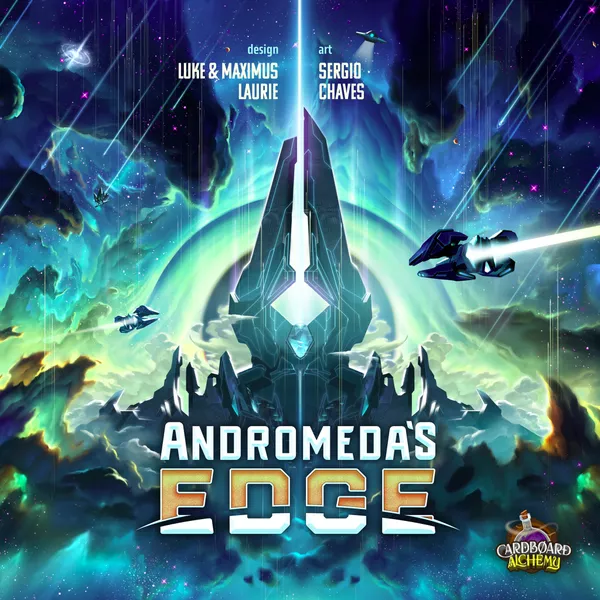Welcome to this week’s review! This week I’m discussing a small, card-drafting, tableau-building game with an extremely cute aesthetic. So without further ado, let’s jump into my thoughts.
Andromeda’s Edge
- Designers: Luke Laurie, Maximus Laurie
- Publishers: Cardboard Alchemy, Lucky Duck Games
- Complexity: Heavy
- Time: 80-160 Minutes
- Players: 2-4
- Main Mechanisms: Worker Placement
I had the opportunity to play a short, three-turn demo of Andromeda’s Edge at PAX Unplugged last year, and while I left that demo with a lot of unanswered questions about the game, there were enough fascinating mechanisms that made me want to try the full, complete version.
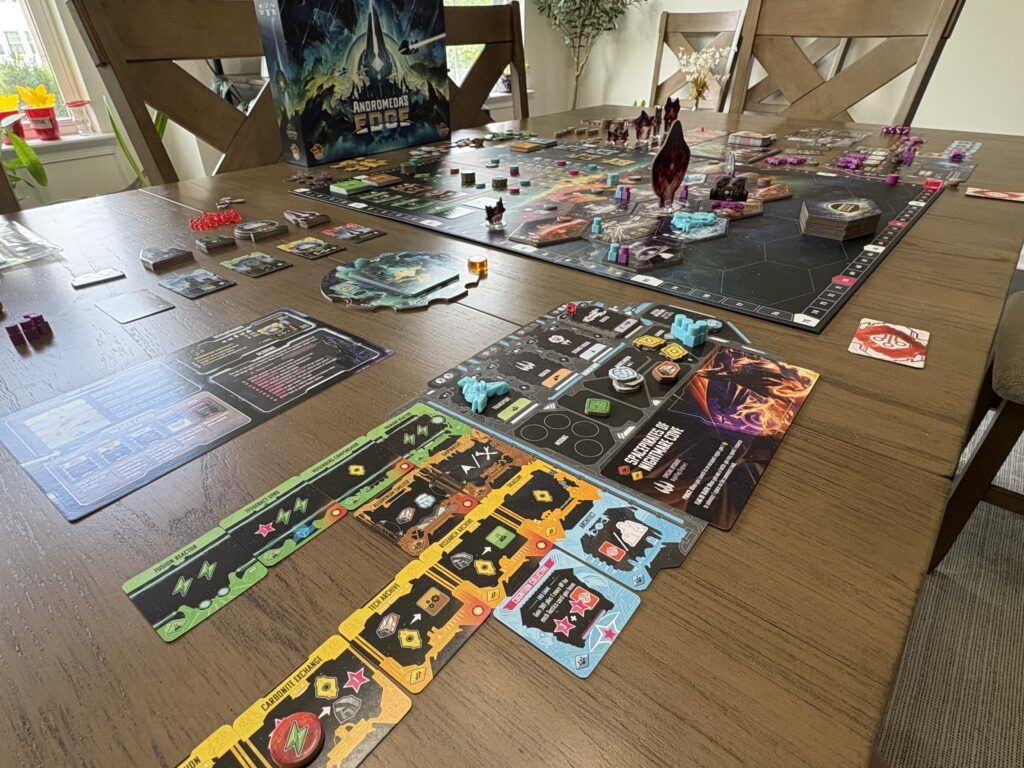
Andromeda’s Edge is the sequel to Dwellings of Eldervale, and while my understanding is that they share a lot of similar mechanisms, I have never tried Dwellings, and thus this review will be from the perspective of someone new jumping in to the series.
In Andromeda’s Edge, players are tasked with taking on the role of a faction and building up a new civilization in an uncharted region of the galaxy. The core of the game revolves around players taking turns either placing one of their ships onto a region and activating that tile, or recalling all of their ships to activate modules on their station. At first glance, this launch-a-ship or recall mechanism is relatively straightforward, and something I’ve seen in other Luke Laurie designs like Whistle Mountain; however, Andromeda’s Edge quickly becomes more than just a worker placement affair.
My favorite part of the game is likely the modules that can be attached to your station. There are four different module decks, and each module is unique. Most modules involve gaining a certain type of resource, but there are others that require you to spend resources to activate other abilities like gaining another module. There are even ones where you can slot in moon tokens that you acquire from visiting planets, which allow you to customize which resources you gain or spend on specific modules. Finally, there are also modules that score you victory points at the end of the game based on certain conditions. Overall, I loved building an engine around certain types of modules, and some of my favorite moments in Andromeda’s Edge are the recall turns where I get to activate my tableau.
Another highlight is the tactics cards. The game comes with a large deck of tactics cards, which are all unique and have different effects. Some can be played during combat to improve your combat strength (adding dice or acting as a dice of a certain value). There are also diplomacy tactics cards that you can play before the start of the combat that can end the fight before it begins. Other tactics cards might give you give you an ability that lasts until your next recall turn. There are a variety of effects, and I found that the tactics cards added a lot of interesting variability to each game.
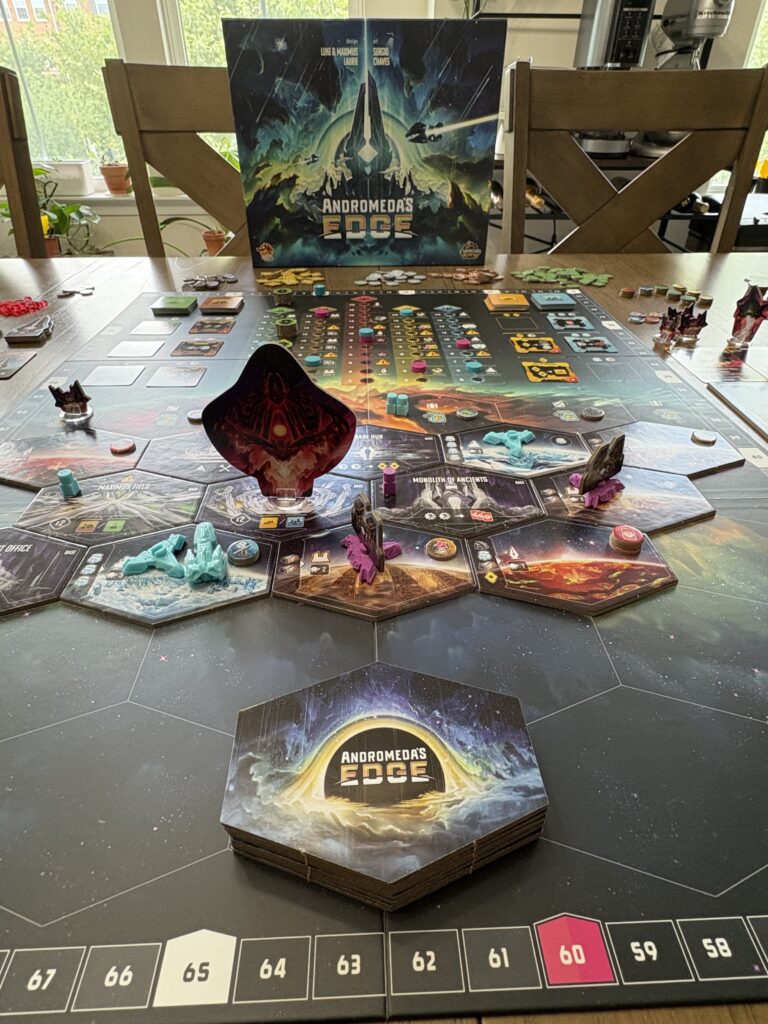
I’m usually not a fan of punishing, in-your-face combat in games, and I’m happy to report that I was pleasantly surprised with combat in Andromeda’s Edge. The core of it involves gaining a certain number of dice dependent on the ships in combat, as well as a targeting mechanism that allows you to reroll dice that are below your targeting value. I found that this targeting mechanism helped mitigate some of the luck element, particularly when you have overwhelming superiority. While it’s never fun when you lose a combat, I never felt it was overly punishing, and even when you lose, you still receive some benefit, for example, a tactics card or resources based on a slotted moon.
I also enjoyed the addition of the neutral raiders because it allowed for more combat opportunities, while not always having to target other players. There can even be some epic combats where you have multiple players and raiders fighting in the same combat.
The game also comes with 12 asymmetric factions in the base game, and there’s a ton of replay value from not only the factions, but also ship upgrades, events, and optional content you can include like special regions (Quasars and Vortexes) and objective cards (Destiny cards).
It’s also worth mentioning that I found the production value in the retail version of the game to be very impressive. While there are no dual-layer boards, I found the cardboard tokens to be very chunky and the plastic ship components were quite cool. Even with just the cardboard raider stands, the game was still quite striking on the table. Even the player dice looked nice. From what I’ve heard, I don’t feel that I’m missing out by not having the deluxe components.
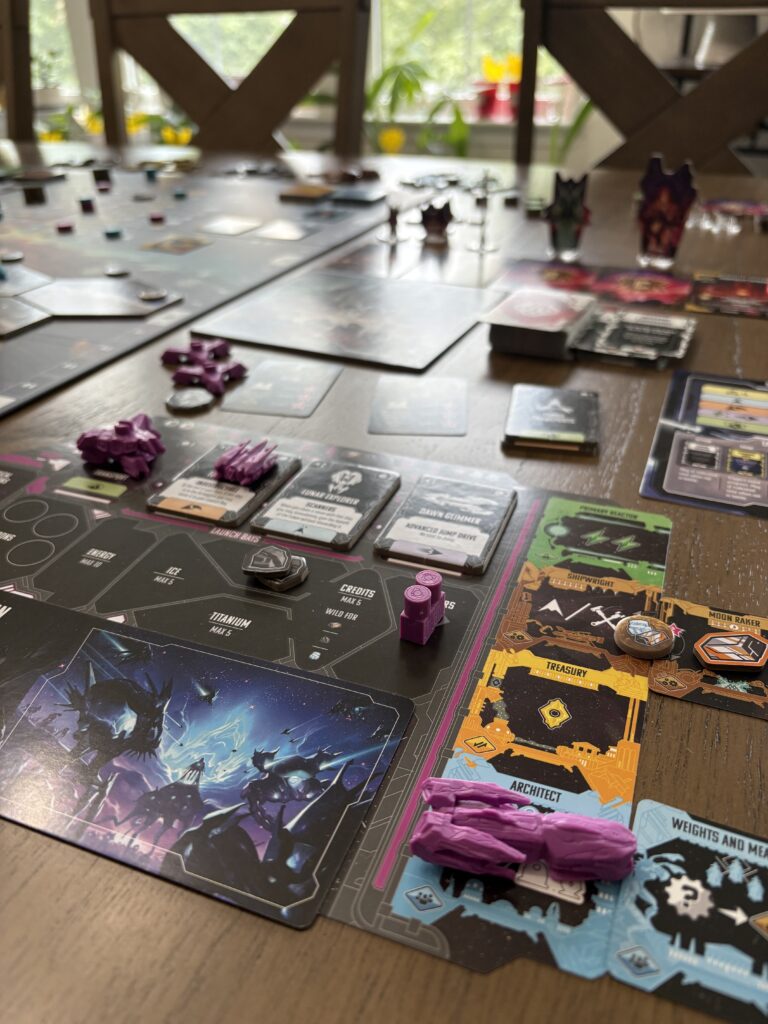
I have a lot of praise for Andromeda’s Edge, but there are also some elements that hold it back from reaching the highest of highs. Probably my biggest complaint with the game is that it can feel clunky at times. For example, while I have a lot of heavy games in my collection, I found this game to be more challenging to grasp initially. I mentioned that the core loop is fairly straightforward (place a ship or recall); however, there are a lot of specific rules that you have to keep in your head. More than some other heavy games that I’ve played recently, I have some trepidation about having to teach this frequently. There are a lot of separate mechanisms and not everything is the most straightforward. There are player aids, but I found that they didn’t quite cover everything you need to keep track of.
Another issue I have with the game is that some turns can feel quite ordinary compared to others. For example, one turn I could visit a planet and take a moon token and that be it. Whereas, on another turn, I could take an Alliance region action to acquire two new modules, trigger a raider strike, have another player join the combat, and then even have an event happen at the end of the turn. This can lead to some quite drawn out turns, which can lead to significant downtime between players. Especially later in the game, recall turns can take a while when you have a large tableau of modules. This issue could be somewhat mitigated by being able to start the next player’s turn while the previous player is finishing their current turn, but I found that often what you’re doing on your turn can directly impact the next player (for example, selecting a new module to acquire or using a module that also gives all other players resources).
I mentioned that some of the luck during combats can be mitigated, but I also found there to some other luck in the game that can feel frustrating. For example, say I’m focused on the green track, but then no green planets get revealed for the rest of the game, limiting my ability to build developments on the track that I’ll score the highest. Some of this is likely better when playing with more players since more planets will come out, but with only two players, I found some of this frustrating. In addition, I played one game where one player started off slowly by losing a few key combats, and they weren’t able to recover for the rest of the game. The game doesn’t really provide any catch-up mechanisms, so if you start off slow compared to the rest of the field, the rest of the game might not feel very satisfying knowing you won’t be able to catch up.
I mentioned that more planets are available with more players, and overall, I think the map element is likely more exciting at higher player counts as there are more opportunities for combat. However, the downside with more players means a much longer game and a lot more downtime as I mentioned earlier. You can choose whether you want to play a short, medium, or long game, but I wish there might have been a bit more player scaling options where I didn’t have to choose between having a more exciting map without significantly adding a bunch of downtime and length.
Finally, setup and takedown can be a bit of a bear. There are tons of decks that need shuffling; not to mention you have to randomly set up the regions, select raiders, choose factions, etc. Along with the long teach, this is a game that I think will be more enjoyable with the same group. It’s also a bit frustrating that the solo mode wasn’t included in the base game and requires you to purchase the expansion.
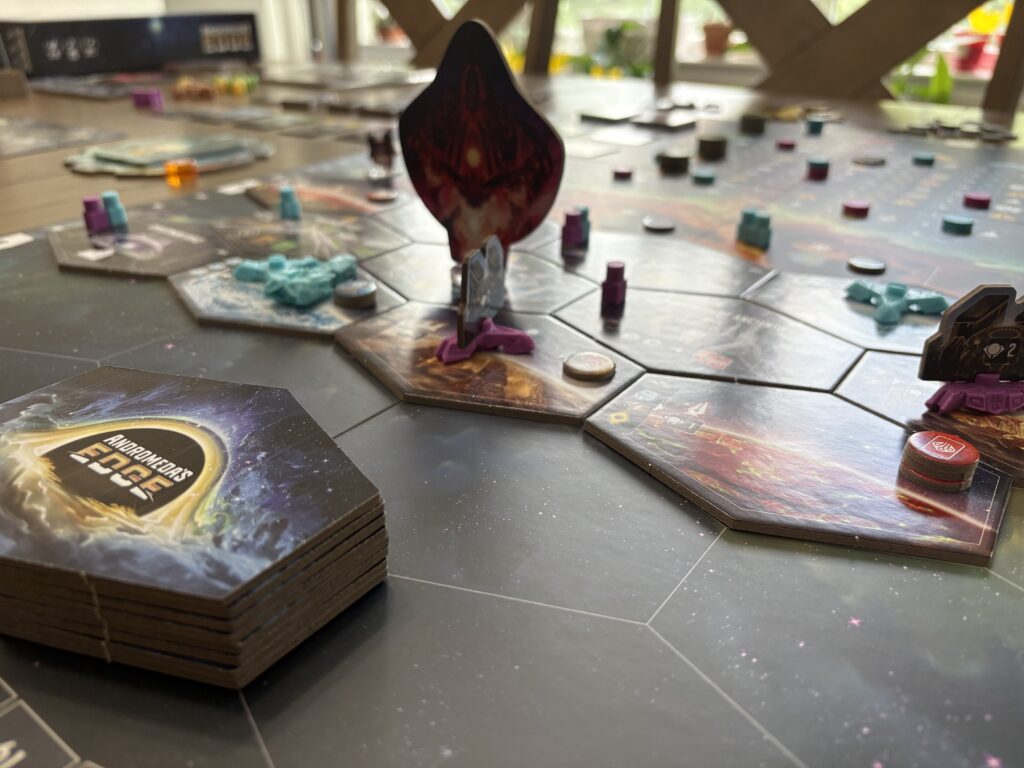
Overall, there is a lot that I enjoyed about Andromeda’s Edge. At its core, the game is still a worker-placement, engine-building game with enough other exciting mechanisms to make it stand apart. I do wish the game was a bit more streamlined and scaled a bit better across player counts, but even with those blemishes, Andromeda’s Edge is easily a keeper.
With that, I’ll wrap up this week’s review! If you’ve played Andromeda’s Edge, I’d love to hear your thoughts on the game, and do you have any other similar games that you enjoy? I’d love to hear your thoughts on any of the games I’ve mentioned or future content suggestions in the comments below. Happy gaming!
If you liked this post and want to be notified when new content is released, then follow me on Instagram @themeepledigest.
